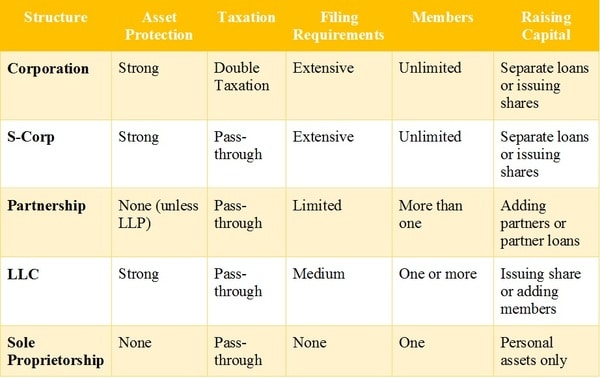Setting up a business can feel overwhelming. There are so many things to consider, including financing, where you will run the business, inventory, and so many other aspects. One of the major decisions that you need to make is what kind of corporate structure will work for your business.
Corporate structures are also helpful to know from an asset protection standpoint as well. Knowing and understanding the various corporate structures can benefit virtually everyone, whether you own and manage your own business or not.
Corporate Structures: The Basics
Although you may automatically think of “corporations” when you hear the term corporate structure, it is actually a much broader term. It includes every legal type of business, from sole proprietorships to huge corporations with thousands of shareholders.
Each structure varies a great deal in several aspects, including:
•Whether it will offer asset protection
•How it is taxed
•Formal filing requirements
•Number of members or owners
•How you can raise capital for your business
Use this primer on corporate structures to help when considering what will work best for your business or as part of your asset protection plan.

The Traditional Corporation (C Corp)
The traditional corporation, also known as the C-corp, is most often used for larger businesses because of the costs associated with development and maintenance.
Asset Protection?
The most appealing aspect of a corporation is that it is a separate legal entity. For this reason, it offers great asset protection. In fact, many people consider it to be the most effective entity for asset protection, assuming you are following the required corporate formalities.Taxes?
The great asset protection attributes of a corporation come at a cost, however. The corporate must do its own separate tax return, and it is taxed independently as well. That means that corporations pay taxes, and its owners pay taxes on the income from the corporation as well. This “double taxation,” makes a traditional corporate structure undesirable for some business owners.Filing Requirements?
Corporations have formal filing requirements in every state. You must generally file articles of incorporation or a certificate of incorporation to have a valid legal entity. Bylaws may also be necessary. There may also be annual or quarterly filings required. Each of these will usually require a nominal fee.Corporations also have recordkeeping requirements, and many states necessitate annual meetings of both the shareholders and the board of directors. You must keep minutes of these meeting as well. These formal elements are important because failing to follow these legal necessities can undermine the corporation’s value as an asset protection tool.
Number of Members?
The number of members of a corporation is virtually endless. Most smaller corporations have just a few shareholders, but publicly traded corporations can have thousands of shareholders. You can have a corporation with just one shareholder as well.Raising Capital?
C-corps can use the sale of stock to raise capital for the company. Selling stock means that you are selling a portion of the ownership of the business to other people. However, shareholders often cannot influence the day-to-day operations of the company.Because corporations are separate legal entities, a corporation can also take out loans or issue bonds on its own as well. Using the corporation as a means to get its own funds allows you to avoid involving your personal assets as well.

S Corporations (S Corp)
An S corp is extremely similar to a corporation, but it has one important difference. The tax treatment is more appealing to many business owners because it is treated as a “pass-through” entity. That is, owners are taxed at the personal level instead of at both the corporate level and on their personal income tax return. The owner just has to make a specific election with the IRS. Virtually all other aspects of an S corp are the same as a traditional corporation.

Partnerships
A partnership is a much more informal business structure compared to a corporation. In fact, it has no formal filing requirements in many states. It seems to work well for smaller companies, particularly those that have low risk.
Asset Protection?
General partnerships offer no asset protection. They are treated as an extension of the individual partners, which means that your and your partners’ assets are up for grabs if the partnership gets into financial trouble. Although it may seem like it, partnerships are not separate legal entities. There are options to develop limited liability partnerships (LLPs) or limited partnerships (LPs) to help deal with the fatal flaw in this business structure.Taxes?
Partnerships do fill out their own tax returns, but it is really more of a reporting requirement than a tax. Each individual partner reports their share of the revenue on their personal return, and they are taxed at the applicable rate based on their individual income. Generally speaking, then, there are no real tax advantages of forming a partnership.Filing Requirements?
There are no formal requirements that partnerships must meet in most states. In fact, you can form a partnership even when you did not deliberately mean to create one – courts use a test that is based on how you and a partner are acting to determine if a partnership exists. Most partnerships will still file with their state, however, because registration is often necessary to obtain required licenses and permits.LLPs and LPs have slightly different treatment, and registration is generally required. Formal partnership agreements are also usually necessary as well. While a general partnership is not required to have a partnership agreement, it is often a good idea to lay out specific terms of the partnership in case a conflict arises later.
Number of Members?
By definition, a partnership is more than one person, but there is no upper limit on the number of partners that can be involved. From a practical standpoint, however, it may make more sense to “upgrade” to a corporation if the number of members becomes overwhelming.Raising Capital?
Partnerships can technically have loans and other financial obligations, but because the individual partner is “on the hook” for all of the debts of the partnership, taking out a loan is really more like the individual partners obtaining financing. For that reason, raising capital can be difficult if partners do not want to put their own assets on the line.Owners can also add additional partners, but that requires sharing some ownership of the partnership, which may not be ideal. LLPs and LPs can add partners that take on a non-management role and act more like investors.

Limited Liability Companies (LLC)
LLC strike an appealing balance between a partnership and a corporation. They offer many of the asset protection benefits of a corporation but they do not have as many cumbersome formalities.
Asset Protection?
Like corporations, LLCs can be great asset protection tools. They are treated as a corporation, which means that owners are not subject to individual liability in most situations.It is important to note, however, that many states do not recognize single-member LLCs as asset protection tools. Often, single-member LLCs are simply an extension of the individual, and they cannot shield assets effectively. Only five states allow single-member LLCs as an asset protection mechanism.
Taxes?
LLCs are not technically a separate legal tax entity, so the business does not have a separate tax rate like a corporation would. Instead, individual members pay income taxes through their own personal taxes – much like a partnership. Some states may tax LLCs, however.An LLC still files a tax return, and it must elect to file as a corporation, partnership, or sole proprietorship. Certain LLCs are still taxed like corporations, however.
Filing Requirements?
LLCs must often file with the state to form the entity. Like a corporation, they will need to submit articles of organization (much like articles of incorporation) and an operating agreement. LLCs also need to obtain required licenses and permits as well.The filing requirements for an LLC are simply not as strenuous as a traditional corporation. Many of the recordkeeping requirements do not apply as well. However, it is important to follow formal requirements to ensure that the asset protection advantages remain in place.
Number of Members?
LLCs can have as few as one member or many members. They work best with a few members. In most states, however, the LLC should have more than one member if you want to use the asset protection attributes of this corporate structure. Technically, however, there are no limitations or requirements regarding the number of members.Raising Capital?
LLCs can have shares just like a corporation. These shares are not as easy to transfer, but they can be a good way to raise capital. Raising capital is otherwise similar to a partnership.

Sole Proprietorship
A sole proprietorship is one of the most common business structures in the United States. That does not mean, however, that it is the best one – or even recommended in many cases.
Asset Protection?
This business type does not offer any asset protection. It is an extension of the individual, and, like a general partnership, it has no asset protection advantages.Taxes?
Sole proprietorships do not have separate tax returns, and any income is added directly into the owner’s income tax return on Schedule C. The applicable tax rate will depend on the individual tax rate.Filing Requirements?
Although sole proprietorships may still need to apply for licenses and permits, there are no formal filing requirements to develop and maintain this type of business structure. This is perhaps the main reason it is so common.You may need to apply for an employer identification number if you have independent contractors or employees, however.
Number of Members?
By definition, a sole proprietorship only has one owner. However, that does not mean that you cannot hire employees or independent contractors. Of course, hiring employees involves an array of other formal requirements that you must meet, including paying unemployment taxes, workers’ compensation, Social Security, and any other state or local tax requirements.Raising Capital?
Obtaining capital for your business as a sole proprietorship can be difficult because you are limited to your own personal finances to get loans or investors.
Choosing the Right Corporate Structure
The right business structure will depend on the size of your business and the industry in which you operate. For asset protection, corporations or LLCs are the most beneficial. From an ease of use standpoint, sole proprietorships or partnerships work well.
As part of the resources that Protect Wealth offers, we discuss the advantages and disadvantages of each of these structures in depth. Getting all of the information you can before you make a decision about corporate structure is definitely a good idea. Sign up for a free membership.
